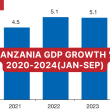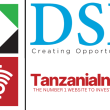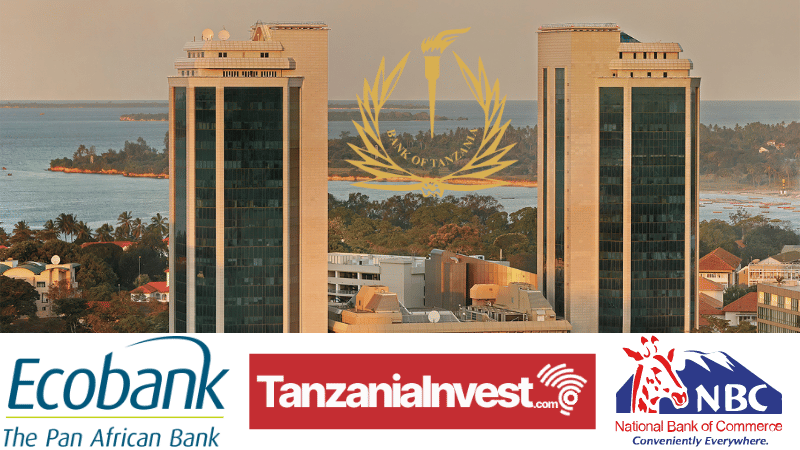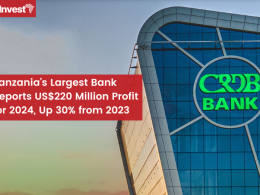Tanzania Banking Sector Outlook
Consolidation
In recent years, Tanzania’s banking sector has witnessed a significant trend towards consolidation. The number of licensed banking institutions operating in the country peaked at 59 in 2017 but has since declined to 53 in 2018, 51 in 2019, 46 in 2020-21, 45 in 2022, and 43 in 2023.
Licensed Banking Institutions in Tanzania, 2018-2023
| Category | 2023 | 2022 | 2021 | 2020 | 2019 | 2018 |
| Commercial banks | 34 | 34 | 34 | 35 | 38 | 40 |
| Development banks | 2 | 2 | 2 | 2 | 2 | 2 |
| Microfinance banks | 4 | 4 | 5 | 4 | 5 | 5 |
| Community banks | 3 | 5 | 5 | 5 | 6 | 6 |
| Total | 43 | 45 | 46 | 46 | 51 | 53 |
In 2018, BOT revoked the banking license of five banks on the basis of their undercapitalization: Covenant Bank, Efatha Bank, Njombe Community Bank, Kagera Farmers’ Cooperative Bank, and Meru Community Bank. BOT also took over the administration of Bank M Tanzania due to the bank’s critical liquidity problems and its inability to meet its maturing obligations.
During the same year, Twiga Bancorp merged with TPB Bank retaining the name TPB Bank. But a new bank entered the crowded Tanzania banking market: China Dasheng Bank (CDBL) which was issued a banking business license in November 2018.
In 2019, the number of banks further decreased with the acquisition of UBL Bank Tanzania by Exim Bank Tanzania, and BoT’s transfer of assets and liabilities of Bank M Tanzania to Azania Bank.
During 2020, the sector experienced further consolidation. In July, BOT licensed Mwanga Hakika Microfinance Bank (MHB) following the merger between Mwanga Community Bank (MCBL), Hakika Microfinance Bank (HK MFB), and EFC Microfinance Bank.
During the same month, NIC Bank Tanzania and the Commercial Bank of Africa (CBA) received regulatory approvals to merge and start operations as NCBA Bank Tanzania, and BOT placed China Commercial Bank Limited (CCB) under statutory administration, transferring all its assets and liabilities to NMB Bank in March 2021.
In March 2021 the National Bank of Malawi plc (NBM) completed the acquisition of a 51% controlling stake in Akiba Commercial Bank. The acquisition is part of the banks’ strategic regional expansion.
In June 2021, the government of Tanzania warranted the merger between two of its controlled banks, TPB Bank and TIB Corporate Bank, a former subsidiary of TIB Development Bank, giving birth to Tanzania Commercial Bank (TCB).
In December 2021, BOT placed Yetu Microfinance Bank (DSE: YETU) under statutory administration for its failure to meet regulatory requirements regarding liquidity and capital adequacy, and in May 2023 it transferred its assets and liabilities to NMB Bank.
In July 2023, Tanzania’s Letshego Bank successfully concluded the merger of its two entities, Letshego Tanzania Limited (trading as “Faidika”) and Letshego Bank Tanzania. The merger has led to the formation of a unified entity, now operating under the new brand name, “Letshego Faidika Bank.”
In July 2023, Standard Chartered and Access Bank (now Selcom Microfinance Bank) entered into agreements for the sale of Standard Chartered’s shareholding in its subsidiaries in Angola, Cameroon, The Gambia, and Sierra Leone, and its Consumer, Private & Business Banking (CPBB) business in Tanzania.
More recently, in June 2024, Selcom Tanzania, a Pan African fintech specializing in digital payments, acquired Access Microfinance, becoming Selcom Microfinance Bank Tanzania.
Clearly, the market is experiencing a consolidation trend, and capital adequacy is a major issue for smaller banks. In this regard, the Governor of Tanzania’s Central Bank Emmanuel Tutuba explains that BOT encourages financial institutions to merge in a bid to enhance their financial muscles and benefit from the synergies of mergers. “Mergers and/or acquisitions may enable financial institutions to have a wider outreach and even provide financing to the country’s strategic projects. However, BOT does not interfere with mergers or acquisition decisions in the financial sector, and that is purely the decision of the financial institutions,” he stresses.
For Muhsin Salim Masoud, Managing Director of People’s Bank of Zanzibar (PBZ) until February 2024, one of the oldest and largest banks in Tanzania, competition is intense with many banks pursuing similar strategies. “Long-term success will require scale, so consolidation of smaller banks through M&A transactions may be necessary and sensible. PBZ will be proactive in considering good opportunities if they arise,” Masoud explains.
Odunayo Akinyede, Managing Director of GTBank Tanzania, one of Africa’s leading banking groups with a widespread presence across 11 countries in Africa and since 2018, Tanzania, shares a similar opinion: “Over the years, we have witnessed a number of banks coming together for various reasons, and I firmly believe that this trend will persist, with more banks opting for consolidation.”
Richard Makungwa, CEO of Mwalimu Commercial Bank Plc (MCB), a commercial bank serving individuals and businesses, believes there are clearly too many banks: “I see some redundancy within the sector. In terms of profit, you’re talking about only a few banks that hold the majority of deposits. So funding is concentrated in those few banks, and smaller banks like ours struggle. There could be mergers, acquisitions, and consolidations happening within the next 5-10 years. So, I foresee larger banks eventually absorbing the smaller ones.”
However, not all segments in banking are saturated; far from it. According to Innocent Ndika, Senior Manager for MSMEs at EQUITY Bank, the market potential is still significant enough to accommodate new entrants in retail and microfinance. ‘We expect to see more banks shifting their strategies from corporate banking to accommodate MSMEs and retail banking,’ he stresses.
The bank’s development strategy towards 2030 is integrated into six pillars: MSMEs, ecosystems of natural resources in agriculture and extractive industries, manufacturing and logistics ecosystems, trade and investment, social transformation and environmental sustainability, and technology-enabled economy.
Fintechs
In addition to a crowded and competitive banking market, it is plausible to expect that the expansion and reach of telcos and fintechs, which have been disrupting the banking space with payment and other solutions that do not require a bank account, will put additional pressure on the sector and further reduce the number of banks successfully operating in Tanzania.
However, for Charles Asiedu, the Managing Director of Ecobank Tanzania, the local subsidiary of the Ecobank Group with a presence in 35 sub-Saharan African countries, banks will always remain relevant due to their importance to the economy and the regulatory framework within which they operate. He explains, “While fintechs and telecom companies bring innovation and agility to the market […] banks should be flexible and agile enough to work with these entities and leverage their strengths. We can expect increased collaboration and integration, but the formal banking system will continue to play a vital role. Regulations will ensure a balance between innovation and stability.”
Indeed, in a bid to encourage and foster innovation in the financial sector, BOT is working towards establishing a Fintech regulatory sandbox that will enable Fintech companies to test innovative and transformative solutions in a controlled environment for financial service delivery in the country.
Theobald Sabi, Managing Director of the National Bank of Commerce (NBC), Tanzania’s third-largest bank, also sees a future where banks and fintechs will work together: “Strategically, we will scale up through partnering with fintechs to develop products that will attract the unbanked population to start using banking services and, as a result, reduce the financial inclusion gap.”
Makungwa is blunt, admitting that developing with fintechs is not an option, but rather a necessity: “We cannot directly compete with fintechs. They have a much larger customer base and wider reach and can offer services like lending directly to customers through mobile platforms. Our strategy is to partner with fintech companies. We already have partnerships for running our mobile banking platforms. We see the value in collaborating rather than competing directly. As for physical branches, we may still need them in specific areas where a physical presence is necessary for effective loan management. However, our focus is on a combination of digital and physical services.”
Meanwhile, Julius Ruwaichi, CEO of Access Microfinance Bank Tanzania, stresses the limits to the use of technologies in financial services in the country: “Many Tanzanians have access to mobile phones and internet. However, there are limited credit products developed and tailored to be made available to many players in Tanzania under the digital platform. More work needs to be done on the data collection/sharing and development of digital credit scoring algorithms. The evolution of Fintechs and innovations can help in unlocking credits for many Tanzanians, especially for small and short-tenured loans. This needs to go hand in hand with cultural change, trust, and financial discipline for the borrowers.”
For Equity Bank Tanzania, the local subsidiary of Equity Group, the largest financial group in East Africa and Central Africa, fintechs provide an opportunity for enhancing efficiency through integration with financial institutions to leverage data and technology.
Its Senior Manager for MSME Innocent Ndika explains that “With the outreach and convenience of the fintech solutions, banks will be able to make use of data and analytics towards designing penetration strategies in financially excluded populations. We are venturing into digital solutions that enable self-service and integration with fintechs for convenience to our customers.”
2023 Preliminary Banks Results
Most large banks in Tanzania have released their unaudited results for 2023, showing strong growth and healthy profits.
An analysis of the 20 largest banks (12 of the 13 first-tier banks and eight more in the middle ranks) shows an aggregate profit before tax in 2023 of TZS 1.5 trillion. This represents a strong increase of 36% from the TZS 1.1 trillion they made in 2022. The income came mostly from the funded interest although the increasing adoption of digital instruments also resulted in an increase in non-funded income, mostly, fees and commissions.
Looking at tier-1 banks, CRDB and NMB, Tanzania’s two largest banks, both posted impressive performances.
CRDB‘s total assets demonstrated a robust 14% growth, expanding from TZS 11.6 trillion in December 2022 to 13.2 trillion in December 2023.
The total loan portfolio experienced a remarkable 23% increase, growing from TZS 6.9 trillion in December 2022 to TZS 8.5 trillion in December 2023. Meanwhile, NPLs remained at just 2.8%.
The bank’s net income (Tanzania’s bank only) grew by %23 from TZS 332.4 billion in 2022 to TZS 409.7 billion in 2023.
CRDB Group CEO and Managing Director, Abdulmajid Nsekela 2023 explained that the successful implementation of the bank’s new medium-term strategy (2023–2027) was behind record-breaking performance. The strategy is centered around cementing the bank’s presence in the Tanzanian market, and sustainably expanding the business.
Nskeela highlighted the strong 35% growth in loans to MSMEs, and notable advancements in financing key segments for greater financial inclusion, namely youth, women, and agriculture.
In this regard, in 2021, CRDB Bank became the first commercial Bank in Africa approved by the Green Climate Fund (GCF), established within the framework of the United Nations Framework Convention on Climate Change as an operating entity of the Financial Mechanism to assist developing countries in adaptation and mitigation practices to counter climate change.
The total funding is USD 200 million (GCF USD 100 million and CRDB Bank USD 100 million), for CRDB Bank to launch three new financial products to support local agribusiness: a dedicated credit line for climate adaptation technologies and practices; a credit guarantee facility to expand access to new borrowers; and a weather-indexed insurance product to help protect against losses from climate-related events.
This program aims to reach more than 6.1 million direct and indirect beneficiaries through the transformation of the country’s climate financing processes to better address affordable climate adaptation technologies in the agriculture sector. This will ultimately lead to boosting food security and enhancing the resilience of the agricultural sector, including smallholder farmers, thereby improving the livelihoods and quality of life of the Tanzanian citizens.
CRDB also increased the usage of digital channels for greater reach, especially the most unbanked and unserved by financial service providers, thus experiencing a growth of 11% in its non-founded income (NFI) in 2023.
NMB posted even stronger growth with total assets up by 19%, expanding from TZS 10.2 trillion in December 2022 to TZS 12.2 trillion in December 2023.
The total loan experienced a remarkable 28% increase, growing from TZS 7 trillion in December 2022 to TZS 7.7 trillion in December 2023. Meanwhile, the NPL ratio was a mere 3.2%.
The bank’s net income (banking only) grew by 26% from TZS 429.3 billion in 2022 to TZS 539.6 billion in 2023.
NMB’s CEO Ruth Zaipuna commented on these results: “NMB Bank profitability levels mark a historic record for the bank and the Tanzanian financial services sector at large. We sustained strong revenue growth momentum [in 2023], with an 18% growth in total income YoY to TZS 1.4 trillion. The growth in revenue has been attributed to a 24% growth in interest income and a 15% increase in non-funded income on the back of significant growth in the bank’s loans book and increased customer activities. In line with our financial inclusion agenda, we were able to open over 1.2 million customer accounts in 2023, bringing our total customer base to over 7.1 Million. Our commitment to the society and environment also remained evident with over TZS 6.2 billion invested in education, health, and climate-related initiatives.”
NBC, Tanzania’s third-largest bank, also posted strong results in 2023. Total assets were up by %14 to reach TZS 3.6 trillion from TZS 2.8 trillion in 2022.
The total loan experienced a remarkable 37% increase, growing from TZS 1.7 trillion in December 2022 to TZS 2.4 trillion in December 2023.
The bank’s net income grew by 49% from TZS 57.2 billion in 2022 to TZS 85.6 billion in 2023.
Tanzania’s fourth-largest bank, EXIM, also saw a solid 26% growth in its total assets, from TZS 2.4 trillion in 2022 to TZS 3.0 trillion in 2023.
In the same period, the bank’s loans and advances went up by 22% from TZS 1.2 trillion to TZS 1.5 trillion, and the profits after tax surged by 25% from TZS 44 billion to TZS 55.2 billion.
However, DTB, Tanzania’s fifth-largest bank, saw a more modest growth in 2023. Its total assets expanded by 12% to reach almost TZS 1.8 trillion from TZS 1.6 trillion in 2022.
Meanwhile, its net loans and advances grew by about 11% from TZS 865 billion to TZS 959 billion, but its net income grew by just 5% to TZS 18.8 billion from TZS 17.9 billion, with NPL up to 7.6% from 6.1%.
Looking at international banking groups, Citi Bank Tanzania, an early player in the market since the liberalization of the 90s, has maintained a focus on corporate banking and once again posted positive results, affirming the profitability of this sector.
However, total assets saw a notable decrease of 28%, falling from TZS 1.2 trillion in Q3 2023 to TZS 913.2 billion in Q4.
Similarly, total loans also decreased by 23% during the same period, dropping from TZS 397.1 billion to TZS 304.5 billion.
Despite these declines, the bank’s net income surged massively by 238%, climbing from TZS 18 billion in 2022 to TZS 61 billion in 2023, with net interest income doubling to TZS 60 billion.
Absa Tanzania, the local subsidiary of the pan-African group, also posted remarkable financial performances in 2023, with total assets surging to an all-time high of TZS 1.4 trillion, a 19% growth from the prior year.
This was accompanied by a growth in customer deposits of 37% year-on-year to TZS 1.1 trillion and an increase in customer loans and advances of 25%.
Meanwhile, the bank’s profit before tax saw a massive surge of 123%, from TZS 34.4 billion in 2022 to TZS 75.2 billion in 2023 (TZS 48 billion after tax).
Its Managing Director, Obedi Laiser, explains that behind these strong performances, there is a focus on innovation to meet customers’ demands: “We have continued to leverage technological advancements, expand our product and service offerings, and foster strategic partnerships to better serve the evolving needs of our diverse customer base.”
BOA Tanzania, the local subsidiary of the pan-African Bank of Africa Group, reported total assets worth TZS 749 billion in 2023, a decrease of 3% from TZS 776 billion in 2022.
Meanwhile, total loans remained virtually unchanged, increasing slightly from TZS 423 billion to TZS 424 billion.
Despite these declines, the bank’s net income surged massively by 108%, rising from TZS 5.3 billion in 2022 to TZS 11 billion in 2023, although net interest income increased by just 13% from TZS 35 billion to TZS 40 billion. This significant improvement in profitability is attributed to the bank’s normalization in impairment losses on loans and advances.
Looking at local banks, state-owned Azania Bank posted impressive results. Its total assets increased by 52% in 2023 to TZS 2.1 trillion from TZS 1.4 trillion in 2022.
Meanwhile, its total loans increased by 70% to TZS 1.6 trillion from TZS 955 billion and its net income grew by 54% from TZS 18.8 billion to TZS 29 billion.
As for other middle-tier lenders, Ecobank, Equity, I&M, Maendeleo, and NCBA saw their profitability more than double in 2023 compared to 2022.
In 2023, Ecobank Tanzania experienced significant growth across various financial indicators. Total assets surged by 27%, reaching TZS 406.7 billion from TZS 320.7 billion in 2022.
Customer deposits saw a remarkable increase of 48% to TZS 274.6 billion, while loans and advances soared by 79% to TZS 164.5 billion, up from TZS 91.7 billion in 2022.
Moreover, the bank achieved an impressive growth in profit before tax, skyrocketing by 496% from TZS 1.6 billion in 2022 to TZS 9.6 billion in 2023, multiplying its profit nearly sixfold.
Equity Tanzania saw its net profit increase four-fold to TZS 9.264 billion in 2023 from TZS 2.264 billion in 2022.
I&M went from a loss of TZS 9.9 billion in 2022 to a profit after tax of TZS 3.74 billion in 2023.
Similarly, NCBA went from a loss of TZS 32.4 billion in 2022 to a staggering TZS 18.28 billion in profit after tax in 2023.
And Maendeleo Bank’s profit after tax went up by almost 50% from TZS 1.41 billion in 2022 to TZS 2.09 billion in 2023.
This success has paved the way for the bank to undertake an ambitious expansion initiative. Its Managing Director, Ibrahim Mwangalaba, recently disclosed that the bank intends to transition from a community bank to a national lender. For this, it has increased its capital from TZS 17 billion to TZS 19 billion, and discussions are underway with the Bank of Tanzania to secure approval for opening branches in other regions of the country.
However, not all banks are enjoying profitability. GTBank Tanzania, a local subsidiary of one of Africa’s leading banking groups and a newcomer to the market in 2018, is among them.
Total assets experienced a 9% increase, reaching TZS 71.6 billion in Q4 2023 from TZS 65.6 billion in Q3.
In contrast, total loans decreased by -14% during the same period, dropping from TZS 20 billion to TZS 17.2 billion.
Despite an improvement from 2022, the bank still recorded a loss, albeit reduced. The loss amounted to TZS 129 million in 2023, down from TZS 747 million in 2022.
However, GTBank remains committed to the Tanzanian market. Its Managing Director Odunayo Akinyede explains: “For us, Tanzania represents a gateway to a new avenue of growth and impact. The country’s thriving sectors such as agriculture, tourism, and manufacturing create a conducive environment for our banking activities. By tapping into these sectors, we aim to foster economic development, facilitate trade, and empower individuals, businesses, and communities across the country. We are committed to leveraging Tanzania’s economic potential, building lasting relationships, and contributing to the country’s overall progress while upholding our mission of being a trusted financial partner in the region.”
The performances of another large, state-owned bank, TCB Bank, are not as exciting as its peers.
During the past few years, the Government decided to merge some of its entities to enhance performance and have stronger, financially sound financial institutions. This resulted in TCB–which used to be known as TPB Bank–taking over the former Twiga Bancorp and the Tanzania Women’s Bank in 2018. And in 2020, TIB Corporate Bank became part of TCB.
With the latest merger, TCB’s assets rose from Sh562.345 billion in 2018 and crossed the TZS 1 trillion to join the first-tier lenders in 2020. In 2022, TBC’s total assets rose to TZS 1.29 trillion, and in 2023 it reached TZS 1.39 trillion, marking a mere 8% growth.
The amount in loans, advances and overdrafts that TCB has loaned to its various customers who are mostly Micro, Small and Medium Enterprises (MSMEs), rose from TZS 617.8 billion in 2020 to TZS 838 billion in 2022, and TZS 911 billion in 2023.
Total loans increased by 8.7% in 2023 to TZS 911 billion, from TZS 838 billion in 2022, while NPLs went down to 8.43% in 2022, and 3.71% in 2023.
Despite these improvements, the bank recorded a loss after tax in 2023 of TZS 46.27 billion, against a profit after tax of TZS 3.15 billion in 2022.
Looking at the microfinance space, Mwanga-Hakika Bank, the results of the merger of two local microfinance banks with the Mwanga Community Bank in 2020, showed the most impressive performances.
Its total assets almost doubled from TZS 116 billion in 2022 to TZS 208 billion in 2023.
Meanwhile, its total loans and total assets reached TZS 131 billion from TZS 80 billion, and its net income went up 128% from TZS 2.8 billion in 2022 to TZS 6.5 billion in 2023.
Looking at specialized lenders, these also posted very positive results. First Housing Finance (FHF), Tanzania’s only mortgage institution, saw its total assets reach TZS 38.1 billion at the end of Q4 2023 from TZS 35.2 billion at the end of Q3 of the same year.
The net interest income reached TZS 3.1 billion in 2023, up 16% from TZS 2.6 billion in 2022, while net profit was up 24% from TZS 284 million to TZS 353 million.
FHF’s CEO Sasa Chonza explains that the default rate for mortgages is relatively low due to the nature of the product and the customer’s commitment to homeownership, with non-performing loans around 2%, compared to the industry average of 5%.
The Tanzania Agricultural Development Bank (TADB), the state-owned development finance institution established to deliver credit facilities for the development of agriculture in Tanzania, posted even stronger results.
Its audited financial statements for 2023 indicate that total assets increased by 35% from TZS 447.7 billion in 2022 to TZS 606.9 billion.
Total loans reached TZS 330.7 billion in 2023, up 25% from TZS 263.8 billion in 2022, while net profit was up 21% from TZS 11.1 billion to TZS 13.5 billion.
Tanzania’s Top 10 Banks By Net Profits in 2023
- NMB: TZS 539.6 billion Bank, TZS 542,466 billion Group
- CRDB: TZS 409.7 billion Bank, TZS 423.7 Billion Group
- StanChart: TZS 91.2 billion
- NBC: TZS 85.6 billion
- Stanbic: TZS 85.1 billion
- CITI: TZS 61 billion
- EXIM: TZS 55.2 billion
- PBZ: TZS 52.7 billion
- ABSA: TZS 48 billion
- KCB: TZS 37 billion
Economic Outlook
According to the World Bank (WB), the GDP of Tanzania expanded by 5.1% in 2023. An improving business climate and the implementation of structural reforms are expected to boost annual GDP growth to 5.6% in 2024, 6.0% in 2025, and 6.4% in 2026.
Similarly, according to the International Monetary Fund (IMF) World Economic Outlook of October 2023, the real GDP growth of Tanzania in 2022 was 5.2% in 2023, and is expected to be 6.1% and 7.0% in 2024 and 2025 respectively.
On the same line, BOT, in its Monetary Policy Committee Meeting Statement, issued in February 2024, estimates that the country’s GDP growth reached 5% in 2023. It also forecasts a GDP growth of 5.5% in 2024.
For its part, the African Development Bank (AfDB) estimates in its Africa’s Macroeconomic Performance and Outlook–January 2023 that the GDP growth of Tanzania was +5.1% in 2023, and will be +6.1% in 2024.
Banking Contribution to GDP
During the 21st Conference of Financial Institutions (COFI) in Arusha held in March 2024, it was revealed that the banking sector experienced a notable growth of 16% in 2023, with most banks achieving historic profits.
Banking outpaced all other economic sectors in terms of growth, surpassing mining and quarrying (10.2%), electricity (10%), arts and entertainment (10%), accommodation and food (8.9%), and information and communication (7.9%).
Governor Tutuba highlighted that the banking sector’s success significantly boosted its contribution to GDP. This was attributed to the effective implementation of financial policies that streamline various processes, supported by digital tools.
However, the current total contribution of the Tanzanian banking sector to the economy stands at about 3.2% of the GDP at current prices, showing a decline over the years.
According to Adam Mihayo, the newly appointed CEO of TCB Bank, this decline is attributed to banks not directing credit to productive sectors of the economy. A large portion of loans issued are personal loans, particularly for employees in formal employment, with over 30% of these loans going to individuals.
BOT’s data for December 2023 revealed that personal loans continued to hold the largest share of outstanding credit at 37.2%, followed by trade at 13.6%, and agriculture at 10.2%.
Abdulmajid Nsekela, CEO of CRDB Bank, attributed this trend to the informality of the Tanzanian economy. He highlighted that the majority of small businesses operate without a formal structure, emphasizing the need to improve policies supporting SMEs.
In response, CRDB signed a USD 100 million loan agreement with the International Finance Corporation (IFC) in 2022 to enhance access to finance for micro, small, and medium-sized enterprises, with up to 25% of the loan allocated to women-owned businesses.
For Ecobank Tanzania, while corporates form the largest part of its portfolio, SMEs and productive sectors are the focus of its expansion strategy. MD Charles Asiedu explained, “We are actively expanding within the value chain of the corporate sector, including SMEs. We’ve diversified our product offerings to cater to all segments, aiming to grow the SME and consumer sides to complement our strong corporate portfolio. Additionally, we’re keen on supporting the agriculture sector as Tanzania strives for self-sufficiency in food production, with platforms to aid commercial farmers and facilitate exports.”
Credit to The Private Sector & Interest Rates
According to the BOT’s Monthly Economic Review-January 2024 which covers the year ending December 2023, extended broad money supply (M3) grew by 14.1%, compared with 11.6% in the year ending December 2022, driven by sustained robust growth of credit to the private sector.
In 2023, private sector credit growth remained strong, albeit declined reaching 17.1% in December 2023, compared with 22.5% in December 2022. However, the growth was above the projected target of 16.4%, reflecting the continued high demand for new loans consistent with the increase in economic activities, backed by the improving business environment.
Credit extended to agriculture maintained the highest growth at 43.5%, followed by mining and quarrying, at 36.4%.
However, high interest rates remain an issue in Tanzania, with an average lending rate of about 16%.
However, banks’ lending rates sustained a downward path, partly explained by the decrease in credit risk in the banking sector. The overall lending rates decreased to 15.34% in December 2023 from 16.06% in December 2022. The negotiated lending rates remained almost unchanged at around 13%.
The overall deposit rates displayed a modest increase to an average of 7.45% in 2023 from 6.94% in 2022. Negotiated deposit rates remained broadly unchanged at around 9%. The spread of one-year interest rates narrowed to 6.99% points from 9.04% points in 2022.
According to BMI Country Risk and Industry Research analysis for Tanzania, the strong economic environment, with falling inflation and robust economic growth, lending will remain strong, supported by low interest rates. BMI expects that the banking sector will report strong profitability again in 2024, and loan quality will continue to improve.
New Interest Rate-Based Monetary Policy
In January 2024, BOT announced a significant shift in its monetary policy framework, transitioning from a focus on the quantity of money (monetary aggregates) to an interest rate-based approach. The move aims to enhance the effectiveness of monetary policy in maintaining stable inflation and supporting economic growth.
In the same month, in an effort to strike a balance between inflation control and economic growth, BOT’s Monetary Policy Committee (MPC) set the Central Bank Rate (CBR), also referred to as the policy rate, at 5.5% for the first quarter of 2024. In its latest Monetary Policy Committee Statement of April 2024, BOT increased the CBR for Q2 2024 to 6%, based on the macroeconomic forecast made in March 2024, which requires an increase in the scope of monetary policy actions to contain the lingering inflationary pressures arising from global economic developments.
BOT’s Governor Emmanuel Tutuba stressed that the adoption of the interest rate-based monetary policy framework does not imply the fixing of interest rates offered by banks and other financial institutions. The interest rates will continue to be determined by market forces in line with other economic policies of the country.
Nonetheless, the CBR will have a direct influence on the cost of borrowing in the country. If the BOT raises interest rates, borrowers with variable-rate loans could experience an increase in borrowing costs, impacting both existing and new debt transactions.
Higher interest rates may also lead to a more conservative lending environment. This could make it more challenging for borrowers to access credit, especially those with lower creditworthiness.
Conclusion
In its latest Monetary Policy Statement Mid-Year Review 2023/24 published in February 2024, BOT explains that in the first half of 2023/24, the Bank implemented monetary policy based on a monetary targeting framework to achieve the inflation target of 5% and facilitate the attainment of a real GDP growth of 5% in 2023 and 5.5% in 2024 for Mainland Tanzania and 7.1% and 7.4% for Zanzibar.
In view of the global and domestic macroeconomic outlook, BOT’s monetary policy will continue focusing on maintaining low inflation and facilitating economic growth. Following the adoption of the interest-based monetary policy framework in January 2024, BIT set the Central Bank Rate (CBR) at 5.5% for the third quarter of 2023/24, while for the fourth quarter, it will be announced in April 2024. This rate aims to contain inflation at 3.2% and steer growth to 5.5% or more in 2024.
BOT projects that the GDP growth in Mainland Tanzania will be 5.5% in 2024 and 7.4% in Zanzibar. The growth projections are attributable to the improving business environment, public investment, a rebound in tourism activities, and implementation of policies and reforms. In addition, on balance, the ongoing rains will contribute positively to output growth.
BOT also explains that the Government is implementing reforms to reduce impediments to the stickiness of lending rates. These include reforms to increase financial inclusion and improve the business environment.
The ongoing implementation of measures to strengthen the resilience and stability of the banking sector is expected to improve further and facilitate intermediation activities. The measures include (i) amendment of the Banking and Financial Institutions Act to allow compliance with the requirements of capital adequacy as a step towards the migration to Basel II/III risk-based supervision standards, (ii) issuance of new Capital Adequacy, Liquidity Management, and Prompt Corrective Action Regulations in line with Basel II/III standards, (iii) implementation of the Real-Time Supervisory Information System to ensure real-time availability of supervisory information to facilitate timely and proactive policy and regulatory actions, and (iv) implementation of the National Financial Inclusion Framework 2023- 2028, which aims at improving access and usage of financial products and services.
With this in mind, the Tanzanian banking sector is expected to remain safe and sound in line with ongoing policy, prudential and regulatory measures undertaken by BOT towards improving business environment and efficiency in financial services delivery.
Additionally, the asset quality is expected to continue to improve, with non-performing loans expected to continue declining as banks continue implementing measures to improve the quality of assets.
Mobile phones will continue to be the key instrument in bridging the infrastructure gap, providing a platform for the unbanked population to access financial services.
And the largest banks are expected to continue to support Tanzania’s economic growth and financial inclusion.
Last Updated: 6th June 2024












